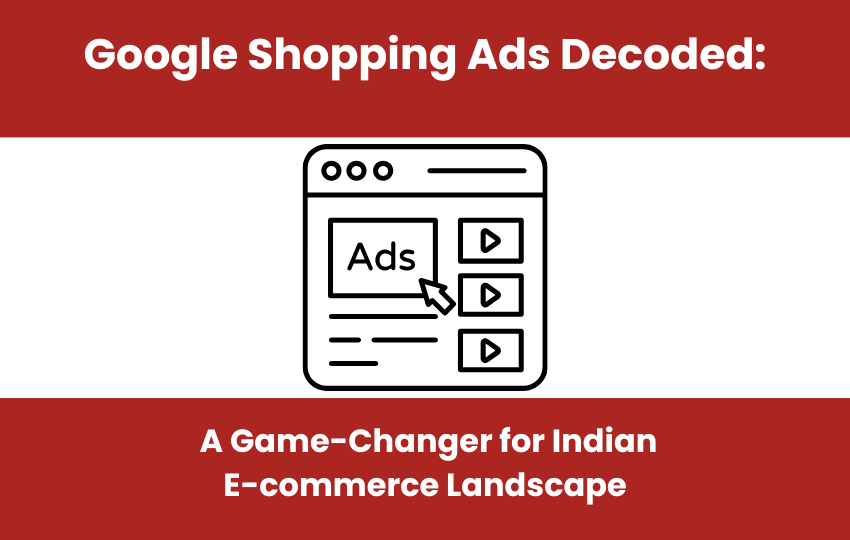
Google Shopping Ads Decoded: A Game-Changer for Indian E-commerce Landscape
In India’s booming e-commerce market, which is expected to reach $200 billion by 2026, standing out is no easy feat. With over 800 million internet users and an ever-growing digital shopper base, competition is fiercer than ever. On top of that, advertising costs are rising, and consumer preferences are evolving at lightning speed.
In this fast-paced environment, businesses must adopt innovative strategies to cut through the noise and capture the attention of increasingly discerning online shoppers. How can you stay ahead in this dynamic landscape? To stay competitive, businesses must turn to an effective solution called Google Shopping Ads.

Google Shopping Ads offer a visually engaging way to showcase products, reaching high-intent buyers at the right moment. However, many businesses face roadblocks—ranging from poor product feed management to high CPCs and low conversions.
In this article, we will explore the most pressing challenges Indian e-commerce businesses face with Google Shopping Ads and provide actionable solutions.
| Pain points | Solutions |
|
|
|
|
|
|
|
|
|
|
Table 1.1 (Pain Points and Solutions)
Challenges Faced in Google Shopping Ads:
Google Shopping Ads can skyrocket sales or drain budgets. Here are five challenges that can make or break success.
1. Poor Quality Product Feed
A well-optimized product feed is crucial for Google Shopping Ads. Errors in product data can lead to disapproved ads, wasted spending, and low visibility.
- Incomplete Product Information: Missing essential details like product title, description, and images can result in low engagement and poor ad rankings, reducing conversion potential.
- Inaccurate Pricing or Stock Information: Discrepancies between the product feed and actual website details lead to rejected ads and customer dissatisfaction, ultimately damaging brand trust.
- Non-compliance with Google’s Guidelines: Failing to follow Google’s structured product feed format may cause feed disapproval, stopping ads from running effectively.
2. High Cost-Per-Click (CPC) and Low ROI

Many e-commerce businesses struggle with high CPC rates and diminishing returns on investment, making it difficult to sustain ad spend profitably.
- Competitive Bidding Pressures: With multiple sellers competing for the same audience, CPC rates can surge, reducing profitability for small and medium businesses.
- Irrelevant Clicks and Poor Targeting: Without proper targeting, ads attract non-converting traffic, leading to wasted ad spend and reduced ROI.
- Lack of Bid Optimization Strategies: Many businesses fail to use automated bidding strategies effectively, missing out on cost-saving opportunities.
3. Low Click-Through Rates (CTR) and Poor Ad Performance
Even if the ads appear, they often fail to attract clicks due to unoptimized content and poor presentation.
- Generic or Unattractive Product Titles: Titles lacking key attributes, benefits, or keywords fail to capture attention in a crowded marketplace, reducing click-through rates and visibility, as shoppers are more likely to engage with clear, compelling, and informative product titles that highlight unique selling points.
- Low-Quality or Unappealing Images: Google Shopping Ads heavily rely on visuals, and poor-quality, low-resolution, or uninspiring images significantly reduce engagement, as shoppers are drawn to high-quality, professional, and visually appealing photos that showcase the product effectively and create a strong first impression.
- Lack of Promotions or Differentiation: Ads without compelling offers, discounts, or unique selling points struggle to drive engagement, as shoppers compare multiple options and are more likely to click on listings with competitive pricing, exclusive deals, free shipping, or added value incentives that stand out.
4. Difficulty in Tracking and Measuring Performance

Many businesses struggle to assess their ad performance effectively, leading to inefficient budget allocation and missed growth opportunities.
- Lack of Proper Conversion Tracking: Without accurate tracking, businesses struggle to measure campaign impact on sales, missing crucial insights into what drives purchases, optimizing bids, and improving ad performance, leading to wasted budget and ineffective marketing strategies that fail to maximize return on investment.
- Poor Use of Analytics and Reports: Failing to analyze performance data results in uninformed decisions, preventing businesses from identifying trends, refining targeting, and optimizing campaigns, ultimately leading to inefficiencies, higher costs, and missed opportunities for improving engagement, conversions, and overall ad effectiveness.
- Ignoring Key Performance Metrics: Overlooking crucial metrics like impression share, bounce rate, and return on ad spend (ROAS) hinders performance improvements, making it difficult to allocate budget effectively, adjust targeting strategies, and enhance overall ad efficiency for better customer acquisition and revenue growth
5. Competing Effectively with Large Retailers
Small and medium businesses often struggle to compete against large retailers with bigger budgets and stronger brand recognition.
- Budget Constraints: Small businesses struggle to compete financially, unable to outbid large competitors who dominate high-demand product categories with higher ad spends, bulk purchasing power, and exclusive deals, making visibility and profitability difficult in competitive markets.
- Low Brand Trust: Consumers naturally gravitate toward established brands, perceiving them as more reliable, making it challenging for smaller businesses to build customer confidence, overcome skepticism, and establish credibility without significant social proof, strong reviews, or sustained marketing efforts.
- Limited Campaign Strategies: Larger retailers leverage sophisticated segmentation, audience targeting, and AI-driven optimizations, maximizing conversions and efficiency, while smaller businesses often lack the budget, tools, or expertise to implement advanced strategies, limiting their ability to compete effectively in digital advertising.
5 Google Ads Remedies To Improve Performance:
Here are five smart fixes for the most common Google Ads problems to help improve your results quickly.
1. Optimizing the Product Feed for Maximum Visibility
Ensuring a well-structured and optimized product feed significantly improves ad performance.
- Regular Feed Audits: Conduct periodic reviews of your product feed using Google Merchant Center to detect and fix errors before they impact ad visibility.
- Automated Feed Management: Utilize tools like Feedonomics or DataFeedWatch to automate product feed updates, ensuring real-time accuracy of pricing and stock levels.
- Adherence to Google Guidelines: Follow Google’s product data specifications to avoid disapprovals. Myntra ensures compliance by structuring their product titles effectively (e.g., “Nike Men’s Running Shoes – Black, Size 10”).
2. Implementing Cost-Effective Bidding Strategies

Reducing CPC while maximizing ROI requires smart bidding and precise targeting.
- Using Smart Bidding Strategies: Leverage Google’s automated bidding strategies, like Target ROAS or Maximize Conversions, to optimize bids based on performance data.
- Negative Keyword Optimization: Regularly update negative keywords to prevent irrelevant clicks and reduce wasted ad spend.
- Segmenting Campaigns by Performance: Split campaigns based on product price, margins, and conversion rates to allocate budget more effectively.
3. Enhancing Click-Through Rates with Better Ad Creative
Optimized titles, high-quality images, and compelling promotions significantly boost ad engagement.
- Improving Product Titles and Descriptions: Use keyword-rich, descriptive titles that highlight key features, such as material, size, and functionality. This improves search visibility, attracts relevant buyers, and enhances click-through rates for better conversions.
For example: Pepperfry enhances its product listings by providing detailed material and dimension specifications. This comprehensive information assists customers in making informed purchasing decisions.
- High-Quality Images and Multiple Angles: Use professional images that meet Google’s best practices, including white backgrounds and high resolution. Lenskart showcases 360-degree views for better customer engagement to improve customer retention as well as meet Google standards.
- Adding Promotions and USP: Offer limited-time discounts, free shipping, or bundle deals to create urgency and attract buyers. Competitive promotions increase click-through rates, differentiate your products, and encourage faster purchasing decisions, helping your ads stand out in a crowded marketplace and drive higher conversions effectively.
For example, Amazon India strategically highlights exclusive offers in its Shopping Ads to attract customer clicks. During events like the Amazon Great Indian Festival, they showcase significant discounts and special deals across various product categories, enticing shoppers with compelling promotions.
4. Advanced Tracking and Performance Measurement

Tracking the right metrics allows for continuous campaign improvement.
- Enhanced Conversion Tracking: Implement Google Ads conversion tracking and integrate it with Google Analytics. This setup improves accuracy in tracking customer journeys, providing insights into attribution, assisting in bid adjustments, and optimizing campaigns based on real conversion data rather than just click-based metrics.
- Merchant Center Insights: Analyze Google Merchant Center reports to identify top-performing products. Adjust ad spend accordingly to maximize profitability, improve product visibility, and refine bidding strategies based on performance trends, seasonal demand, and consumer behavior patterns.
- Tracking Key Metrics: Monitor ROAS, click-through rate, and impression share regularly. Identify underperforming areas, adjust bids, optimize targeting, and enhance ad creatives. Continuous tracking ensures data-driven decisions, leading to improved campaign efficiency and maximized return on investment.
5. Competing Effectively with Large Retailers
Small ecommerce businesses can compete successfully by focusing on niche products, audience targeting, and personalized experiences.
- Focusing on Niche and High-Margin Products: Instead of competing on generic products, target niche categories with less competition. Nykaa gained traction by focusing on premium beauty products instead of generic cosmetics.
- Using Google Shopping Custom Labels: Classify products using custom labels based on profit margins, demand, and sales trends. Prioritize high-margin or best-selling items for aggressive bidding while lowering bids on low-performing products. This strategy maximizes ad spend efficiency and improves overall campaign profitability.
- Personalizing Retargeting Strategies: Use dynamic remarketing to target past visitors with personalized ads. Meesho improved conversion rates by using AI-driven remarketing strategies to showcase relevant products based on browsing history.
Conclusion
At Cybez, we help e-commerce businesses in India overcome challenges like high CPCs, low conversions, and competition. Our google ads expert team optimizes product feeds, enhances ad creatives, and implements smart bidding strategies to maximize visibility, improve ROI, and drive sustainable growth with data-driven, AI-powered Google Shopping Ads management.
Get in touch now for a tailored strategy that delivers real results.
FAQs
1. How can I lower CPC on Google Shopping Ads?
To reduce CPC, use smart bidding strategies like Target ROAS, refine audience targeting, and optimize negative keywords. Regular bid adjustments and segmenting campaigns based on product performance can also improve cost efficiency.
2. Why are my Google Shopping Ads not generating sales?
Low conversions can result from poor product feed quality, irrelevant targeting, or weak ad creatives. Ensure accurate product data, high-quality images, competitive pricing, and optimized product titles to attract high-intent buyers.
3. How do I compete with large retailers on Google Shopping?
Focus on niche products, leverage custom labels to prioritize high-margin items, and use dynamic remarketing. Personalized ad strategies and strategic bidding can help small businesses stand out against big retailers.

